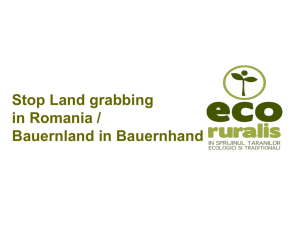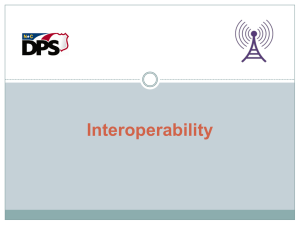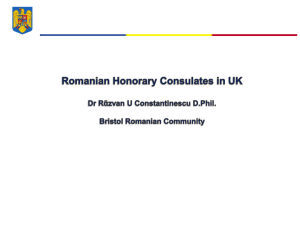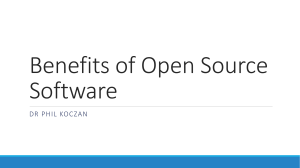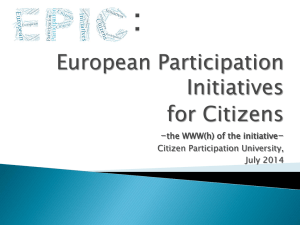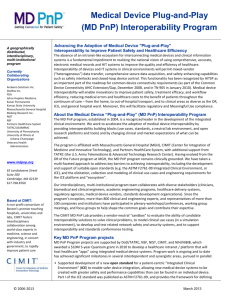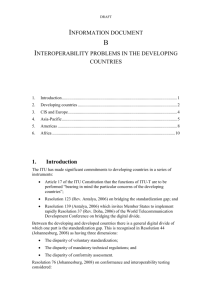Click to add title - Global Meeting on Government Interoperability
advertisement
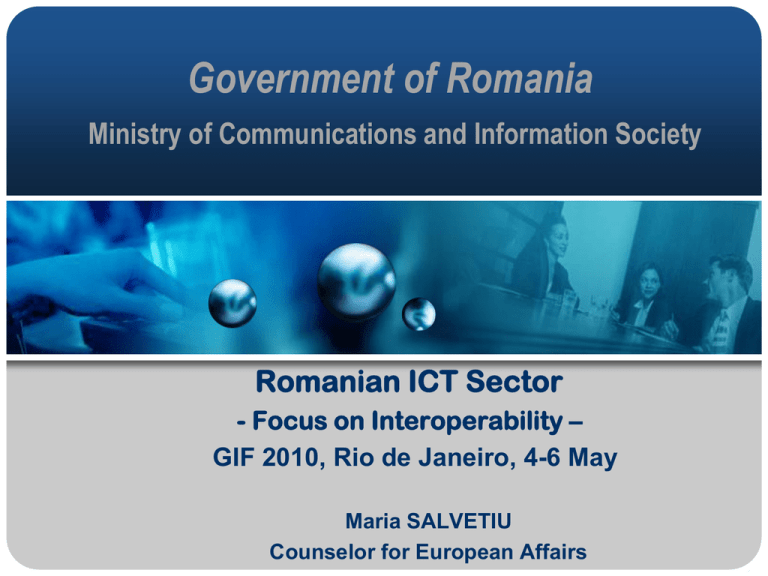
Government of Romania Ministry of Communications and Information Society Romanian ICT Sector - Focus on Interoperability – GIF 2010, Rio de Janeiro, 4-6 May Maria SALVETIU Counselor for European Affairs Short Facts about Romania It is situated at the crossroads of Central and Southeastern Europe, at North of the Balkan Peninsula, bordering on the Black Sea. Member of the European Union since January 1st, 2007. The 9th largest territory and the 7th largest population (with 21.5 million people) among the EU Member States. Its capital and largest city is Bucharest, with 1.9 million people. Romania joined NATO in March 2004, it is a member of the Latin Union, of Francophonie, of the OSCE and of the United Nations. It is also an associated member of the Community of Portuguese Language Countries. Information Society in Romania – Factsheet The information society is at early stages of development in Romania. The use of eProcurement, an important development for this country, is progressing at a good pace. In November 2008 it was published its eGovernement strategy which aims at improving the performance of the public administration at the service of citizens. This is complemented by the eStore Portal for the promotion of electronic commerce and the business networks and by initiatives aiming at enhancing digital inclusion to reduce the rural-urban digital divide, stimulate the use of ICTs in schools as well as facilitating the interaction between citizens and administration. Broadband penetration is growing slowly and now stands 11.7%, the third lowest in the EU. Broadband coverage is still limited, translating into low take up of broadband by both households and enterprises. On the positive side, one third of all broadband subscriptions are fast (+2MB/s), suggesting good basis for future leapfrogging of traditional broadband access. (Source: Europe's Digital Competitiveness Report: i2010 - ICT Country Profiles by European Commission 2009) Information Society in Romania – Factsheet Internet Usage Despite a gradual increase over the past few years, Romania records the lowest rates of regular and frequent internet use in the EU. On the whole, most internet services are used to a significantly lesser degree than on average in the EU. Although the take up of eGovernment services by citizens and enterprises is one of the weakest in Europe, the availability of online public services for enterprises exceeds the EU27 average, as does use of e-procurement. ICTs in the Economy. Levels of eCommerce and eBusiness are still low. The eSkills base is also relatively weak. The ICT industry is nevertheless somewhat important for the Romanian economy: although it contributes little to total GDP (3.6%) and employment (1.5%), it is responsible for 5.3% of total exports. Source: Europe's Digital Competitiveness Report: i2010 - ICT Country Profiles by European Commission 2009) Romanian electronic communications market Snapshot in figures Penetration rates/100 - the main electronic communications services and infrastructures 133.0%133.5% 140.0% 112.4% Population: 21.5 million Territory: 238,391 sq km Population urban/rural: 55.2/44.8% Households: 7,320,202 120.0% 100.0% 15% broadband* 80.0% 53.6% 60.0% 53.7% 48.3% 49.8% 47.7% 46.7% 30.4% 32.1% 40.0% 23.0% 20.0% 0.0% Fixed Mobile 31.12.2007 Internet access 31.12.2008 31.12.2009 * Broadband includes fixed and mobile access of at least 128 kbps speed Cable 1 Who’s who 2 Romanian GIF Who’s Who Who’s Who Ministry of Communications and Information Society (MCIS) Responsibilities: ensures strategic planning and defines the strategic and tactic objectives in the field of electronic communications, postal services, information technology, information society services and knowledge based economy services defines, implements, monitors and evaluates the policies required to achieve such objectives encourages efficient investments in infrastructure promotes and stimulates the research, innovation and technology transfer in the field of electronic communications, postal services, information technology, information society services and knowledge based economy Relevant subordinated institutions: National Center “Digital Romania” National Center for Management of Information Society Institute for Research in Informatics Who’s Who Ministry of Communications and Information Society (MCIS) Priorities: implementation of the National Strategy “eRomania 20102013” implementation of the Government Strategy regarding the development of the broadband communications in Romania 2009-2015 Implementation of the National Strategy regarding the deployment of universal service in the electronic communications field Strategy on the digital switchover (transition from terrestrial analogue to digital television) Who’s Who National Authority for Management and Regulation in Communications (ANCOM) = an autonomous public institution with legal personality, subordinated to the Parliament, fully financed from its own revenues Responsibilities: enforcing the national policy in the fields of electronic communications, audio-visual communications and postal services, including through market regulation and technical regulation in these fields economy services; administrates and manages the limited resources in the filed of electronic communications, including, among others, the radio frequency spectrum, the numbering resources and other associated technical resources, and monitors the radio frequency bands with nongovernmental use; controls the fulfilment of the requirements regarding electromagnetic compatibility, of the obligations regarding the efficient use of the radio frequency spectrum with nongovernmental use, controls the fulfilment of the obligations on the use of the numbering resources. Romanian GIF Romanian objectives in the interoperability field Interoperability is a key goal of MCSI, allowing local authorities to develop various levels of digital city, to implement their own services at regional, county or town level. E-government at local level integrated in the e-government systems at central level, and conducted in accordance with specific needs and requirements of each local authority is one of priority directions taking into consideration the need for decentralization. Different systems will also be able to communicate with each other. Therefore, the solutions eGovernment will be designed according to internationally recognized open standards and interfaces. The Interoperability framework in Romania will be partly funded by European structural funds. National Interoperability Framework (NIF) Law NIF Law includes policies and technical specifications to achieve interoperability between systems, products, software, application or service accessible through the National Electronic System (NES) NIF Law sets minimum conditions for facilitating communication, security, data and information exchange between administration, citizens and the private sector standards National Interoperability Framework (NIF) Law INTEROPERABILITY NIF Law systems services applications products software public administration citizens private sector NES Principles 1. increasing the efficiency and effectiveness of information systems which provide electronic public services 2. increasing efficiency in the use of public funds 3. raising the citizens’ comfort 4. safer systems of local and central public administration 5. reuse of resources involved in the computer systems 6. improving collaboration between public administration institutions 7. increasing maturity, support and popularity in the market 8. promoting web accessibility 9. facilitating cooperation at European and international level Legal Framework and Technical Standards a) use of electronic public services directly from its own interface to the National Electronic System (NES) b) exchange of information between two or more systems of public administration through a central node c) accessing data and information stored in the national registers d) the framework and technical standards will refer to relevant international standards Objectives for Developing and Implementing the National Interoperability Framework (I) 1. Providing standardized and accessible web interface for accessing and providing public information and electronic services 2. Standardization, promotion and adoption of XML as the current standard for data exchange between electronic public services 3. Standardization, adoption, use and refining models used to structure data (metadata), as needed, according to international ISO standards, open or public 4. Alignment of standards and specifications used in the Internet, developed by specialized organizations and supported at European level (W3C, ISSS, OASIS, IETF, etc.) alignment tracking systems to provide electronic public services to those standards or specifications Objectives for Developing and Implementing the National Interoperability Framework (II) 5. Adopt, support and use of "open" standards and widely used specifications, supported by the private market, to reduce overall costs for maintenance and development of electronic public services 6. Promoting the benefits arising from the use of open technologies 7. Review of policies, standards and specifications already implemented in existing systems for providing electronic public services in order to align their existing European level in the IT industry and widely supported by large technology platforms, software and applications, most used in industry public. Functional Considerations 1. Single authentication implementation in the public administration systems 2. Unified access to electronic public services 3. Defining the primary database and how to interconnect them 4. Defining mechanisms of collaboration between public administration systems 5. Interoperability with similar systems in Europe 6. Defining security standards for the public administration systems Conclusions - The Law on Interoperability is under the final stage of adoption - Its methodological norms are under elaboration by MCIS - It complies with the European legislation on Interoperability Frameworks - Romania being part of the Interoperability Expert Group, under ISA (Interoperability solutions for public administrations) Programme of European Commission www.mcsi.ro Thank You !

